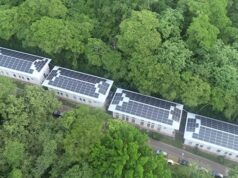 Finding the right HVAC system to cool commercial spaces does not have to mean making a choice between high-quality performance and efficiency, but it does take homework.
Finding the right HVAC system to cool commercial spaces does not have to mean making a choice between high-quality performance and efficiency, but it does take homework.
In order to make the most informed decisions, facilities managers and building owners need to be mindful of not only the purchase and installation price but its protected service life and operational costs. Once the numbers are crunched, it is often found that the most energy efficient equipment offsets a larger up-front price and more than makes up for it in long-term operational savings.
Look at the Full Picture
Something to keep in mind when evaluating HVAC equipment is to not make decisions based only on the full load efficiency of a system. Consulting engineers will often size equipment based on worst-case environmental scenarios to ensure there will be enough cooling or heating capacity available. It is rare for the equipment to encounter such extreme temperatures.
So, it pays to evaluate the part-load efficiency of the HVAC unit being scrutinized as well as the part-load of the whole system. It is also important to choose equipment that can efficiently modulate capacity to match the demand. This can help reduce the operating costs even further while improving the indoor air quality (IAQ) overall.
Correctly calibrating the size of the equipment to the true load of the space means it will not end up frequently cycling on and off. This reduces wear and tear on the unit and prevents discomfort caused by temperature swings and inadequate dehumidification.
HVAC systems being used in settings with large numbers of occupants need to be able to introduce large amounts of outside air to provide healthier IAQ. Look for equipment that can condition and dehumidify massive amounts of outside air efficiently at part-load.
Ventilation Challenges
One of the challenges that comes with introducing a large amount of outdoor air into interior spaces is the higher energy usage required to condition it. The temperature and humidity levels of outdoor air varies far more widely than straight room return air, and this must be accounted for.
This has resulted in the increasing growth of energy recovery technology in the HVAC industry. These devices, mostly commonly a plate heat exchanger or a heat recovery wheel, temper the incoming air using energy from previously conditioned room air. The devices can recover about 60 percent of the energy cost associated with conditioning the air, reducing operational costs. They also allow smaller systems to be used to serve spaces than what otherwise would be required.
There are also features such as electronic expansion valves and digital scroll compressors that can be used to allow HVAC equipment to better modulate cooling capacity while maintaining tight control of the temperature of the supply air.
Maintenance
Do not forget the role of maintenance in keeping HVAC equipment running at top efficiency. Here are some potential problem areas to consider.
Filter: Look for spots that are plugged or are visibly restricted. If filters are not changed regularly, it can restrict airflow and put more strain on the overall HVAC system. This means extra energy use and wear and tear on components such as fan motors.
Belts: When inspecting belts, check for signs of aging, stretching, fraying or misalignment. Belt problems can lead to poor or no airflow, failure of compressor parts, and frosting/icing of evaporator coils.
Electrical Components: When inspecting electrical components, ensure all connections are tight. Check for frays and discoloration. Problems that can be caused by neglect can include premature component failure and excessive energy use.
Coils: It is important to keep indoor (evaporator) and outdoor (condenser) coils clean. Remove dirt, dust, and debris. Neglect can lead to the failure of electrical parts, motors, or compressors.
Drain pans: Drainage problems can damage the HVAC unit itself and cause water damage within the facility. Ensure drain pans and traps are clear and free flowing by flushing them to remove any buildup.
Although it is easy to tell if something is wrong with your HVAC system if it’s not working correctly, problems aren’t always easy to spot. Adopt a regular maintenance and inspection routine to identify and fix issues before they become major issues.
Choosing high-efficiency HVAC equipment that optimizes the needs of your space will pay off. Base decisions on a true picture of the needs of your facility, protect your investment with regular maintenance, and reap the rewards of long-term operational savings.
Jason Gillis is regional sales manager for Modine.







